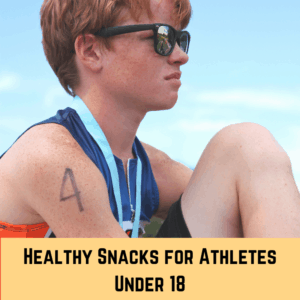The Young Athlete: Ultimate Guide to Nutrition
March 20, 2023
The young athlete has unique nutrition needs which are the key to performance and healthy growth. Let’s dive into how to feed your athlete whether they’re playing recreation or elite sports.
Sports Nutrition is near and dear to my heart. As a mother of four young athletes and a pediatric dietitian specializing in sports nutrition for kids and teens, I believe that good nutrition is the key to athletic performance.
Over the years, I’ve worked with many children who got their nutrition advice from misinformed coaches, the media and the sports world. I’ve seen firsthand how nutrition myths and the snacking culture in children’s sports negatively affects their performance and puts them at risk for unhealthy consequences.
In my book, Eat Like a Champion, I give parents an in-depth and doable roadmap to feeding active and athletic children.
This article breaks down what you need to know to get started with balanced and nutritious meals that fuel the young athlete for performance and growth.
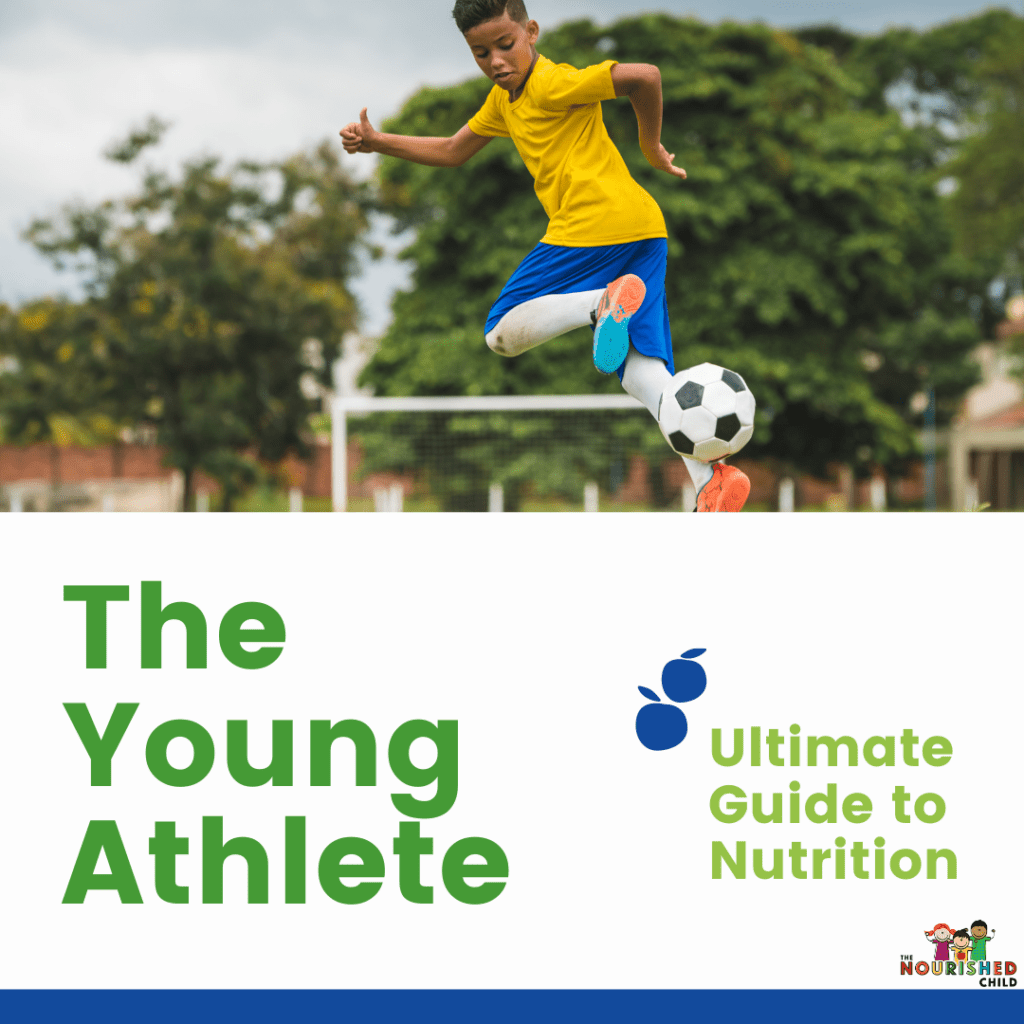
Sports Nutrition Myths
Before we dive in, let’s start with popular myths among children in sports.
1. Cut out carbohydrates versus carb-load
The myth that the young athlete needs to cut out carbs or carb-load before a competition is pervasive. Kids need carbohydrates as part of a balanced meal, and active kids need to make sure they eat enough carbohydrate foods because activity demands more.
Carbs are the body’s preferred fuel and without them, the body will use its own muscle as a source for carbohydrates and energy.
What about loading up on carbohydrates before a competition? Kids playing endurance or rigorous elite sports need more carbohydrates to fuel training and replace the body’s stored carbohydrates. But loading up on carbs before a competition may lead to an energy crash, especially if other nutrients, like protein, are missing.
2. Need sports drinks to rehydrate
Most kids aren’t active enough to need sports drinks. They are a source of unnecessary sugar. Sugar-free alternatives have artificial sweeteners, which I don’t recommend for kiddos.
Water is good enough to rehydrate kids playing moderate intensity sports like baseball.
If your child plays higher-intensity sports like rowing or track and field for more than one hour, they’ll need water and electrolytes. I believe in food first.
For the young athlete, bananas and pretzels or beef jerky have enough potassium and sodium to replenish electrolytes.
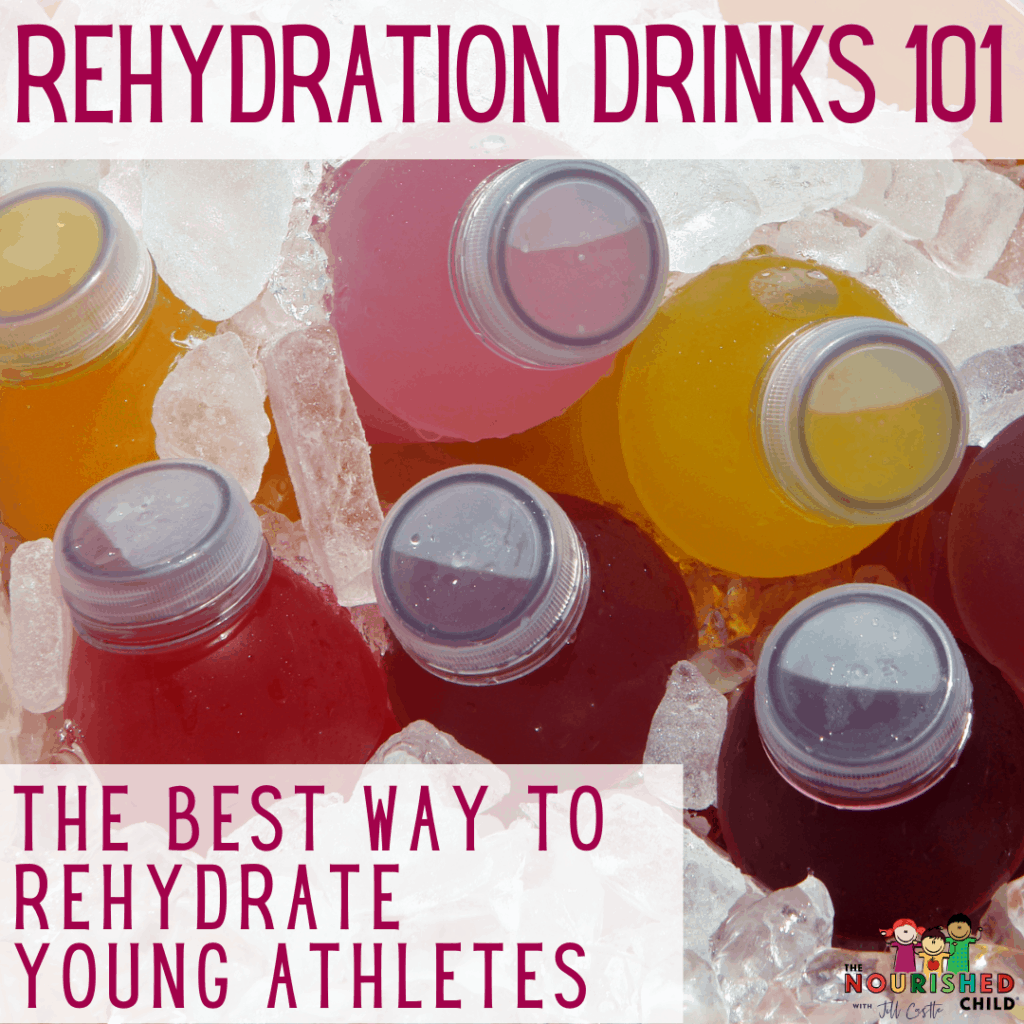
3. The young athlete needs extra protein
Yes, young athletes need more protein compared to inactive children. But they don’t need as much as you might think. The body doesn’t use protein as an energy source. Rather, protein is used to repair and build muscles, but consuming too much ends up stored as body fat.
Diets that have excessive amounts of protein can lead to dehydration. All three macronutrients are important but the goal is to have quality fats, carbohydrates and protein in balance.
4. Food quality doesn’t matter
Another big myth is that playing sports compensates for unhealthy eating habits. Health isn’t about calories. Vitamins and minerals help the body function and create energy.
Most athletes are fine with meeting the RDA of vitamins and minerals. But, young athletes risk coming up short on crucial nutrients when sugar and salty, fatty foods replace nutritious meals and snacks.
While they may use up the calories on the field from those ultra-processed foods, young athletes will feel sluggish and may not perform at their potential.
Why Is Nutrition Important for the Young Athlete?
Kids are young and seem to have endless amounts of energy.
Do they really need a special diet for sports?
That depends.
The two primary goals of feeding young athletes are to provide the nutrients for growth and the fuel they need for more energy for sports.
The young athlete is still growing so their calorie and nutrient needs are even higher. For the most part, the nutrition recommendations I give young athletes are the same I give for all children, except for a few tweaks here and there depending on the sport.
Athletes need to fill their tanks or they’ll run out of steam during practice or competition. This can range from feeling sluggish and not performing optimally to dehydration, which can be dangerous.
But not all sports are the same.
If your athlete practices for 2 to 3 hours at a high level he’ll need an extra snack or meal and more water than a child playing a less rigorous sport.
What Are the Nutritional Needs of the Young Athlete?
Nutritional needs change throughout childhood and adolescence. Kids go through several growth spurts until they finish puberty and stop growing.
Generally, boys have higher muscle mass and stop growing later than girls so their calorie needs are quite high through young adulthood. While girls reach their adult height earlier and have less lean muscle on average, their calorie and nutrient needs tend to be lower starting in adolescence.
But every child has a different genetic makeup, body composition and activity level.
The 2020-2025 Dietary Guidelines for Americans break down energy needs based on age and activity level in the table below.
Energy Needs for Active Children and Teens
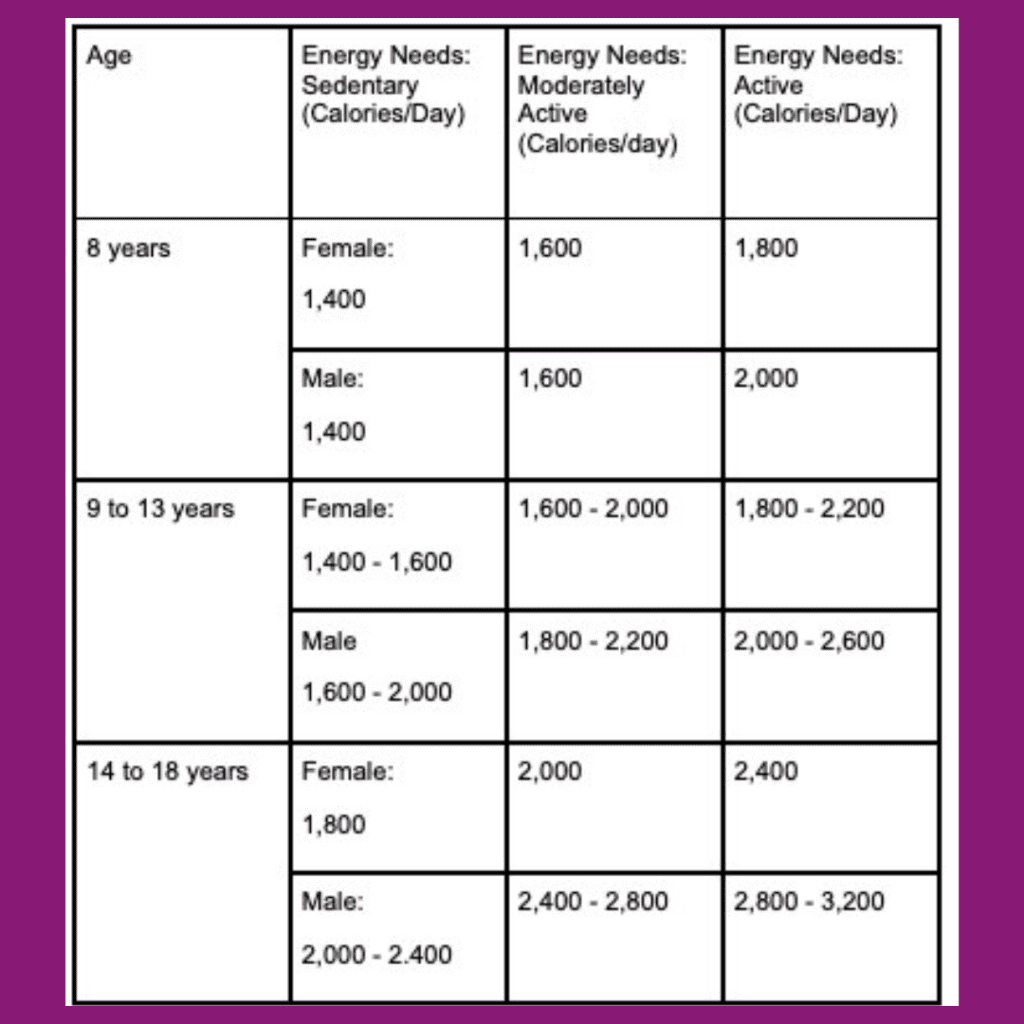
What Are the Major Nutrients for the Young Athlete?
The best meals and snacks for your athlete should include protein, complex carbohydrates, and plant fats.
Quality macronutrients make up a healthy, balanced diet. But, the amount of each macronutrient within a food contains doesn’t tell the entire story.
Here’s a comparison of two very different foods.
Example 1
- Calories: 270
- Protein: 3g
- Fat: 15 g
- Carbohydrates: 29 g
Example 2
- Calories: 113
- Protein: 1 g
- Fat: 10 g
- Carbohydrates: 5.9 g
Which food is the best fuel for a young athlete?
It’s hard to determine the quality of food by looking at the grams of fat, carbohydrates and protein.
Example one is one serving of a popular brand of potato chips (49 g). Example two is half an avocado.
The avocado may be low in protein and high in fat, but it contains healthy monounsaturated fats, complex carbohydrates, 9 grams of fiber and other vitamins and minerals. While potato chips contain saturated fats and simple carbohydrates, and they’re very high in sodium.
Neither of these foods would be adequate alone. A combination of healthy fats, protein, and complex carbohydrates can help your child feel full longer and give him more energy on the field.
The key is to provide meals with nutrient-dense foods without focusing too much on the numbers.
Now let’s look at each macronutrient.
Complex Carbohydrates
Carbohydrates are the body’s preferred energy source, and kids need them in their diet.
There are two kinds of carbohydrates. There are complex carbohydrates, which I like to think of as “slow” carbs. And simple carbohydrates, which I call “fast” carbohydrates.
Complex carbohydrates are digested slowly and don’t cause a jump in blood sugar followed by a crash. Examples of complex carbs include whole grains like brown rice, whole wheat pasta, quinoa, slow cooked oats, and whole grain bread.
Simple carbohydrates break down fast and cause a spike in blood sugar. White table sugar and most foods made with sugar such as candy, soda, cookies or other desserts, are examples of simple carbohydrates. Although your athlete may get a jolt of short-term energy, it won’t last and they may end up lethargic, cranky, unable to focus, nor have the energy to get through practice.
Fruit and dairy also have carbohydrates. The high fiber content of fruit helps whole fruits break down slower so they are complex carbohydrates (even though fruits are high in the natural sugar called fructose). Fruit juice, on the other hand, is concentrated, and the fiber is removed. So juice is a simple carbohydrate that digests quickly.
Protein
Protein builds and repairs muscle after a practice or a game.
Animal protein is a complete protein that contains all the essential amino acids. Plant proteins may miss some essential amino acids, so combining them, like beans and rice, can ensure it’s a complete source.
Animal proteins contain saturated fat also so focus on lean quality proteins like chicken, turkey, fish, eggs, legumes and beans.
What about protein supplements?
I get the question all the time about protein supplements and shakes. I believe in food first. Over the years I’ve worked with families to tweak the diets and timing of meals for young athletes.
If that wasn’t working, or the child needed additional nutrients, we looked at adding supplements or perhaps a protein powder.
Many families might not realize that supplements, including protein powders, aren’t regulated by the FDA. They can include allergens, heavy metals, and even sports enhancers, which can be dangerous and disqualifying in elite sports that test for human growth hormone (HGH) or other sports enhancers.
There’s also the possibility of overdoing protein. My suggestion is to steer clear of supplements and focus on quality balanced meals and snacks.
If your athlete eats a plant-based diet or has a vitamin deficiency, a pediatric dietitian can make adjustments to the diet or suggest the best supplements.
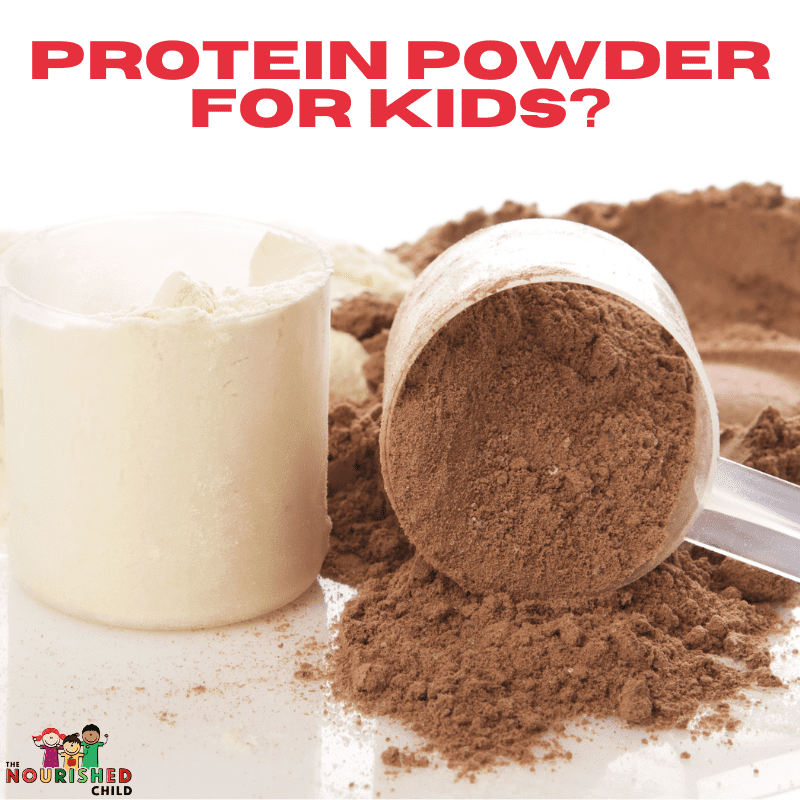
Fat
Athletes should include polyunsaturated and mono-unsaturated fats in their meals and snacks. I’m not talking about the fat you find in fast food or chips. Too much of those kinds of fats, especially before competition or practice can make your athlete feel sluggish.
Monounsaturated and polyunsaturated fats are the brain-boosting omega-3 fats. These are mainly found in plant foods including avocados, olive oil, nuts, seeds, and nut butter.
Vitamins and Minerals for the Young Athlete
Whether your child plays recreational or elite sports, physical activity doesn’t compensate for poor food choices. Moderate and intense physical activity puts an even higher demand on a young athlete, especially for calories and nutrients.
Nutrients are necessary for healthy growth and development and a deficiency during childhood can have a long-term impact on a child’s cognitive and physical potential.
Here I highlight the most important vitamins and minerals for young athletes:
- Iron – athletes are at a greater risk of iron deficiency anemia. Iron transports oxygen throughout the body and muscles need oxygen to function. During physical activity, red blood cells break down. So iron is an essential nutrient for athletes.
- Calcium and vitamin D – kids and teens are growing and have higher calcium and vitamin D requirements to keep their bones strong and healthy as they grow in height.
- B vitamins – B12, B6, folate, riboflavin, and thiamin are B vitamins that help the body make energy and are necessary for all the body’s functions.
A balanced diet focuses on quality foods that have a variety of these nutrients. I’ve included the requirements in the chart below to give you an idea of what your athlete needs. Instead of focusing on the numbers, use the food sources as a guide for putting together meals and snacks for your athlete.
Micronutrient Requirements for the Young Athlete
| Micronutrient | Age (years) | RDA/AI | Sources |
| Iron | 8 9-13 14-18 | 10 mg 9 mg 11 mg (male) 15 mg (female) | Breakfast cereals fortified wih iron; white beans; dark chocolate; hummus; lentils; spinach; tofu; beef; baked potato; cashews; chicken; whole wheat bread; raisins; egg |
| Calcium | 8 9-13 14-18 | 1,000 mg 1,300 mg 1,300 mg (male) 1,300 mg (female) | Plain yogurt; mozzarella cheese; cheddar cheese; milk; soymilk; fortified orange juice; tofu; cottage cheese; canned salmon; ready-to-eat cereals; raw kale; vanilla ice cream; bok choy; broccoli |
| Vitamin D | 8 9-13 14-18 | 600 IU 600 IU 600 IU (male) 600 IU (female) | Cod liver oil; swordfish; salmon; canned tuna fish; fortified orange juice; fortified milk; yogurt; egg; ready-to-eat cereals |
| B12 | 8 9-13 14-18 | 1.2 µg 1.8 µg 2.4 µg (male) 2.4 µg (female) | Beef liver; clams; fish; beef; poultry; eggs; milk; and other dairy products; some breakfast cereals; nutritional yeast |
| Folate | 8 9-13 14-18 | 200 µg 300 µg 400 µg (male) 400 µg (female) | Beef liver; spinach; black-eye peas; fortified breakfast cereals; rice; asparagus; avocado; bread |
| B6 | 8 9-13 14-18 | 0.6 mg 1 mg 1.3 mg (male) 1.2 mg (female) | Chick peas; beef liver; tuna; salmon; chicken breast; breakfast cereals; potatoes; turkey; banana; spaghetti sauce; waffles; bulgur; cottage cheese |
| Thiamin | 8 9-13 14-18 | 0.6 mg 0.9 mg 1.2 mg (male) 1.0 mg (female) | Lentils; green peas; brown rice; white rice; enriched bread; fortified breakfast cereals; wheat germ; pork; pecans; spinach; orange; cantaloupe; milk; egg |
| Riboflavin | 8 9-13 14-18 | 0.6 mg 0.9 mg 1.3 mg (male) 1.0 mg (female) | Milk; cheddar cheese; egg; almonds; salmon; halibut; chicken; beef; broccoli; asparagus; spinach |
| Niacin | 8 9-13 14-18 | 8 mg 12 mg 16 mg (male) 14 mg (female) | Yeast; chicken; tuna; turkey; salmon; beef; breakfast cereals; peanuts; pasta; lentils; lima beans; bread; coffee |
| Vitamin C | 8 9-13 14-18 | 25 mg 45 mg 75 mg (male) 65 mg (female) | Fruits and vegetables; ready-to-eat cereals |
| Vitamin A | 8 9-13 14-18 | 400 µg 600 µg 900 µg (male) 700 µg (female) | Milk; eggs; leafy green vegetables; tomato products; some vegetable oils; fortified ready-to-eat cereals |
| Vitamin E | 8 9-13 14-18 | 7 mg 11 mg 15 mg (male) 15 mg (female) | Wheat germ oil; sunflower seeds; almonds; sunflower and safflower oils; peanut butter; spinach; broccoli; kiwifruit; mango; tomato |
| Zinc | 8 9-13 14-18 | 5 mg 8 mg 11 mg (male) 9 mg (female) | Oysters; beef; crab; fortified breakfast cereal; lobster; pork; baked beans; chicken; yogurt; oatmeal; almonds |
| Selenium | 8 9-13 14-18 | 30 µg 40 µg 55 µg (male) 55 µg (female) | Seafood; organ meats; breakfast cereals; other grains; dairy products; Brazil nuts; enriched macaroni; ham; cottage cheese; brown rice; egg; whole wheat bread; bananas |
| Magnesium | 8 9-13 14-18 | 130 mg 240 mg 410 mg (male) 360 mg (female) | Green leafy vegetables; spinach; almonds; cashews; peanuts; seeds; black beans; edamame; breakfast cereals; whole wheat bread |
How Much Water Do Kids Need?
One of the biggest mistake kids make is not hydrating enough or correctly. Sometimes kids don’t drink enough and sometimes they drink too much, especially right before a big competition.
Your athlete might worry he’ll need to use the restroom in the middle of a game so he avoids drinking enough water beforehand. But, dehydration during intense exercise is dangerous.
The opposite, loading up on water right before the game, isn’t a good idea either. The key is to stay hydrated throughout the day and show up for the game adequately hydrated.
Athletes need more water than the average amounts on the chart below. iIn my book, Eat Like a Champion, I outline the recommendations of 13 milliliters per kilogram per hour, and what that might look like for a young athlete.
Keep in mind kids need even more water to stay hydrated when they train for longer than two hours or in the heat.
Fluid requirements of kids and adolescents:
| AGE | TOTAL WATER* (CUPS/DAY) |
| 8 | 6 cups |
| 9-13 | 10 cups (males) 9 cups (females) |
| 14-18 | 14 cups (males) 10 cups (females) |
*Food contains water, which counts towards your child’s daily fluid requirements.
What about sports drinks?
Have you ever wondered if kids really need sports drinks to replenish their electrolytes?
Most kids probably don’t need the additional boost of electrolytes from a sports drink to rehydrate.
Kids playing recreational or low-intensity sports only need water.
Elite athletes playing at a higher intensity and for longer have options. They can rehydrate with water and replenish electrolytes with foods that contain potassium (fruit and veggies) and sodium (pretzels, beef jerky), or go the sports drink route.
Nutrition Tips for Young Athletes
The best athletes know that quality and timing of food matter as much as quantity. Here are a few tips to get the most out of food to improve performance, maintain energy and satisfy hunger and appetite longer.
- Food combinations – Combine protein with fruits and vegetables to stabilize blood sugar, feel satiated longer, and have the energy and fuel on the fields
- Whole grains – include whole grains throughout the day especially the night before and the morning of a competition. The fiber in whole grains keeps the GI tract moving and slows the absorption of carbohydrates so your athlete won’t get a sugar spike and crash.
- Timing and frequency of meals – when and how often young athletes eat can improve their performance. Small frequent balanced meals keep blood sugar steady. And the timing of meals before and after training fuel an athlete’s energy and performance.
- Family meals – busy kids sometimes skip meals or eat fast food and snacks with friends when they’re on the go. You can’t always control what your athlete eats when he’s out so the family meal is an important strategy to help him eat like a champion.
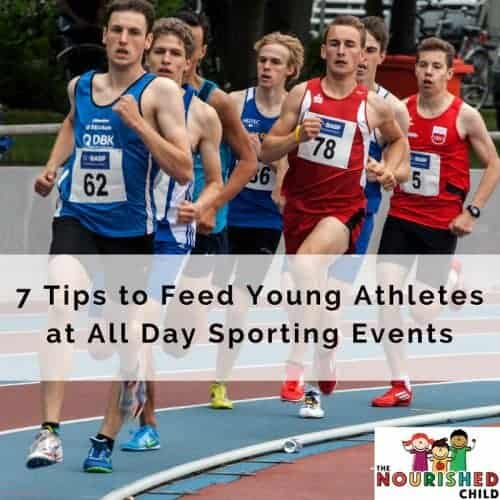
Competition Nutrition
Last-minute nutrition and short-term extreme measures before competitions aren’t enough if your athlete wants to perform well in an elite sport.
Nutrition to fuel training and competition is an ongoing process that starts in the pre-season. During competitions, what young athletes eat before and after intense physical activity can affect their performance.
Here are a few tips:
- Hydrate adequately before, during and after the competition but not all at once right before going on the field. Too much water can cause an imbalance in electrolytes and be as dangerous as dehydration.
- Don’t skip meals before a big competition.
- The night before a sporting event, have a meal of quality protein, whole grains, some fruit and/or vegetables and milk.
- Sleep is important and sometimes big meals (carb loading) may keep your athlete tossing and turning all night, especially with the pre-competition jitters. So keep the meal the night before light.
- The morning of a competition, have another light and balanced meal. Loading up on carbohydrates or protein will not help your athlete perform better. Always go for balance.
- Pack light snacks for all-day tournaments and sporting events and hydrate frequently.
Recovery after competition
The quantity and food combination depends on how rigorous your athlete’s sport is. Recovery snacks should have a combination of carbohydrates and protein.
Kids that play moderate activity sports for less than an hour are probably fine with no additional snacks.
For 1 hour of moderate activity, a small snack like a piece of bread with peanut butter and milk is enough to refuel.
For longer periods of intense activity, your athlete might need a large snack or another meal.
Healthy Meals and Snacks for Teenage Athletes
The focus of good nutrition for athletes should be on balance, quality and timing. Try to fuel your athlete with food first and skip the sports drinks, protein shakes and supplements.
Balanced breakfasts
One of the biggest obstacles for families is trying to wrangle the kids together to sit down for a meal. The one meal you have control over is breakfast even if it’s something small, quick and easy that your athlete can eat on the way out the door.
Here are some breakfast ideas for young athletes to start the day:
- Whole grain toast, egg, a piece of fruit and a cup of milk
- Greek yogurt with nuts and berries
- Oatmeal with peanut butter and fruit
In my e-book, Fast and Nutritious Breakfasts for Young Athletes, I give parents a load of options and ideas for simple breakfasts.
Dinner
Family dinners don’t have to be elaborate five-star meals. Simple can also mean tasty.
Some athletes skip meals and run low on fuel then overeat at the next meal. If your athlete is ravenous when he comes home for dinner, it may be time to add another snack during the day or between lunch and dinner.
Here are some examples of the top foods athletes should eat. Use these food combinations as a guide and spruce up meals to fit your family’s food preferences:
- Salmon, sweet potato, a green vegetable and milk
- Omelet with vegetables and fruit on the side
- Chicken or a lean cut of beef, brown rice, vegetables
You’ll find more easy meal options in my e-book, Fuel up! Dinner Recipes for Young Athletes.
Snacks that Fuel the Young Athlete
Healthy snacks help keep blood sugar steady between meals and add needed nutrients to your athlete’s diet. For athletes, pre- and post-exercise snacks are part of recovery and are important for repairing and replenishing the body.
Here are some snacks that will give your athlete the staying power between meals and on the field:
- Nuts and dried fruit
- Greek yogurt and fruit
- Whole wheat bread and peanut butter with a glass of milk
- Banana and beef jerky
- Hummus and vegetables
- Cheese and fruit
- Half a sandwich
- Granola (look for low sugar options)
If you want more ideas for snacks for your athlete, get my free guide. (FREE OPTIN)
Special Considerations for Young Athletes
As a pediatric dietitian, I’ve heard many concerns from parents and young athletes while also observing some concerning things firsthand over the years. Sometimes the line between taking care of your body and fueling for sports turns into disordered eating, which can snowball into an eating disorder.
My advice for parents is to look out for any changes in eating behavior that’s concerning like skipping meals, cutting out food groups, and taking extreme diet measures before a competition. This is especially a concern with sports that require young athletes to make weight.
These are some of the biggest issues I see with young athletes:
- Underweight athletes – Underweight athletes may forgo quality and use energy-dense junk food to bulk up. Instead bulk up by adding quality proteins and healthy fats like avocados, nut butter, nuts and seeds and full fat dairy.
- Female Athlete triad – Eating Disorders among female athletes can lead to what’s called the Female Athlete Triad. The three elements that make up the triad are an eating disorder, amenorrhea or abnormal periods, and osteoporosis.
- Relative Energy Deficit in Sport (RED–S) – this is a syndrome whereby poor health and declining athletic performance occur due to inadequate energy intake and/or burning too many calories in sport. It can happen in boys and girls.
- Media influence – celebrity and influencer diet culture and social media can be harmful to the well-being of kids and teens. Most of the diet advice children see on social media is unhealthy for kids, young athletes, or for anyone!
Nutrition is the key to improving performance on and off the field. If you want to dive deeper into this topic, check out my course for the young athlete, Eat Like a Champion, so they learn how to fuel their bodies for sports and growth.
Ready to get started with fueling your young athlete? Take the first step and revamp those snacks with my FREE Snack Ideas for the Young Athlete printable!



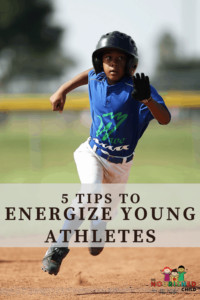
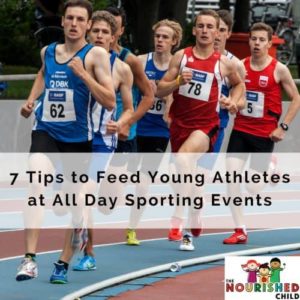
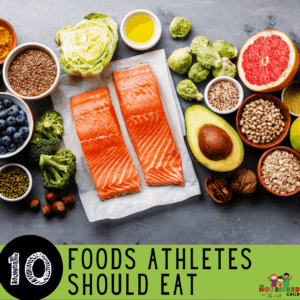

![Game Day Granola [Recipe]](https://thenourishedchild.com/wp-content/uploads/2015/11/Game-Day-Granola-e1447270901887-300x300.jpg)
